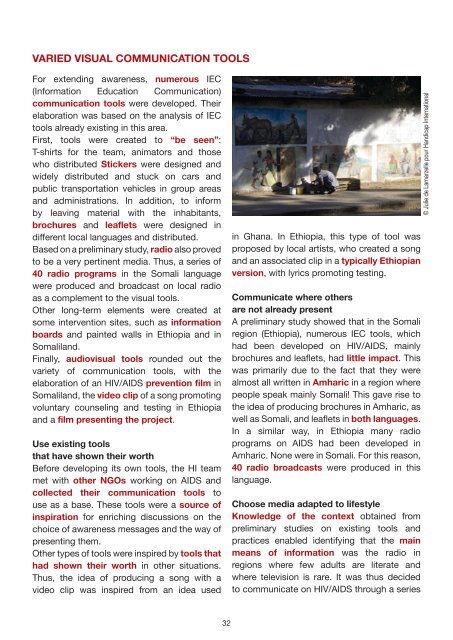Anchoring Awareness in the Community - Handicap International
Anchoring Awareness in the Community - Handicap International
Anchoring Awareness in the Community - Handicap International
You also want an ePaper? Increase the reach of your titles
YUMPU automatically turns print PDFs into web optimized ePapers that Google loves.
VARIED VISUAL COMMUNICATION TOOLS<br />
For extend<strong>in</strong>g awareness, numerous IEC<br />
(Information Education Communication)<br />
communication tools were developed. Their<br />
elaboration was based on <strong>the</strong> analysis of IEC<br />
tools already exist<strong>in</strong>g <strong>in</strong> this area.<br />
First, tools were created to “be seen”:<br />
T-shirts for <strong>the</strong> team, animators and those<br />
who distributed Stickers were designed and<br />
widely distributed and stuck on cars and<br />
public transportation vehicles <strong>in</strong> group areas<br />
and adm<strong>in</strong>istrations. In addition, to <strong>in</strong>form<br />
by leav<strong>in</strong>g material with <strong>the</strong> <strong>in</strong>habitants,<br />
brochures and leaflets were designed <strong>in</strong><br />
different local languages and distributed.<br />
Based on a prelim<strong>in</strong>ary study, radio also proved<br />
to be a very pert<strong>in</strong>ent media. Thus, a series of<br />
40 radio programs <strong>in</strong> <strong>the</strong> Somali language<br />
were produced and broadcast on local radio<br />
as a complement to <strong>the</strong> visual tools.<br />
O<strong>the</strong>r long-term elements were created at<br />
some <strong>in</strong>tervention sites, such as <strong>in</strong>formation<br />
boards and pa<strong>in</strong>ted walls <strong>in</strong> Ethiopia and <strong>in</strong><br />
Somaliland.<br />
F<strong>in</strong>ally, audiovisual tools rounded out <strong>the</strong><br />
variety of communication tools, with <strong>the</strong><br />
elaboration of an HIV/AIDS prevention film <strong>in</strong><br />
Somaliland, <strong>the</strong> video clip of a song promot<strong>in</strong>g<br />
voluntary counsel<strong>in</strong>g and test<strong>in</strong>g <strong>in</strong> Ethiopia<br />
and a film present<strong>in</strong>g <strong>the</strong> project.<br />
Use exist<strong>in</strong>g tools<br />
that have shown <strong>the</strong>ir worth<br />
Before develop<strong>in</strong>g its own tools, <strong>the</strong> HI team<br />
met with o<strong>the</strong>r NGOs work<strong>in</strong>g on AIDS and<br />
collected <strong>the</strong>ir communication tools to<br />
use as a base. These tools were a source of<br />
<strong>in</strong>spiration for enrich<strong>in</strong>g discussions on <strong>the</strong><br />
choice of awareness messages and <strong>the</strong> way of<br />
present<strong>in</strong>g <strong>the</strong>m.<br />
O<strong>the</strong>r types of tools were <strong>in</strong>spired by tools that<br />
had shown <strong>the</strong>ir worth <strong>in</strong> o<strong>the</strong>r situations.<br />
Thus, <strong>the</strong> idea of produc<strong>in</strong>g a song with a<br />
video clip was <strong>in</strong>spired from an idea used<br />
<strong>in</strong> Ghana. In Ethiopia, this type of tool was<br />
proposed by local artists, who created a song<br />
and an associated clip <strong>in</strong> a typically Ethiopian<br />
version, with lyrics promot<strong>in</strong>g test<strong>in</strong>g.<br />
Communicate where o<strong>the</strong>rs<br />
are not already present<br />
A prelim<strong>in</strong>ary study showed that <strong>in</strong> <strong>the</strong> Somali<br />
region (Ethiopia), numerous IEC tools, which<br />
had been developed on HIV/AIDS, ma<strong>in</strong>ly<br />
brochures and leaflets, had little impact. This<br />
was primarily due to <strong>the</strong> fact that <strong>the</strong>y were<br />
almost all written <strong>in</strong> Amharic <strong>in</strong> a region where<br />
people speak ma<strong>in</strong>ly Somali! This gave rise to<br />
<strong>the</strong> idea of produc<strong>in</strong>g brochures <strong>in</strong> Amharic, as<br />
well as Somali, and leaflets <strong>in</strong> both languages.<br />
In a similar way, <strong>in</strong> Ethiopia many radio<br />
programs on AIDS had been developed <strong>in</strong><br />
Amharic. None were <strong>in</strong> Somali. For this reason,<br />
40 radio broadcasts were produced <strong>in</strong> this<br />
language.<br />
Choose media adapted to lifestyle<br />
Knowledge of <strong>the</strong> context obta<strong>in</strong>ed from<br />
prelim<strong>in</strong>ary studies on exist<strong>in</strong>g tools and<br />
practices enabled identify<strong>in</strong>g that <strong>the</strong> ma<strong>in</strong><br />
means of <strong>in</strong>formation was <strong>the</strong> radio <strong>in</strong><br />
regions where few adults are literate and<br />
where television is rare. It was thus decided<br />
to communicate on HIV/AIDS through a series<br />
© Julie de Lamarzelle pour <strong>Handicap</strong> <strong>International</strong><br />
32

















